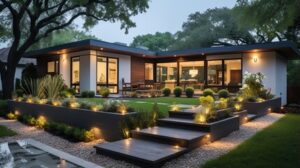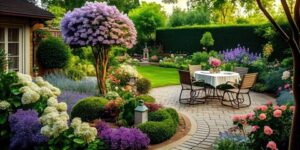Landscape lighting provides a unique opportunity to transform outdoor spaces with a visually stunning effect. This type of lighting can highlight focal points like garden features, water elements, and architectural features.

It can also add safety by illuminating pathways and other potential tripping hazards. Choosing the right bulbs and fixtures is important to achieve your desired effects. Visit https://orlandolandscapelighting.net/ to learn more.
Uplighting casts light upward to highlight vertical features of your landscape, creating a dramatic effect and drawing attention to your home’s exterior or other architectural elements. It’s ideal for highlighting trees, garden statues or fountains, or to illuminate walkways and paths. This type of lighting also works well for illuminating retaining walls, flagpoles and other prominent features on your property.
When choosing an uplighting fixture, make sure to choose LEDs over halogen bulbs for their long life and energy efficiency. Also opt for fixtures with a dimmer setting, which allows you to control the amount of brightness. For optimal results, have a professional landscape lighting designer install the system.
Downlighting is the opposite of uplighting, focusing light downward to create a wash of illumination over larger areas of your landscape. This technique is great for illuminating planting beds, ground-level shrubbery and hardscaping, and subtle architectural elements that don’t require the drama of uplighting.
Proper maintenance is key for ensuring that your landscape lighting systems work properly and look their best year-round. Clean fixtures regularly to remove dirt and debris that may obstruct their light output. Trim vegetation regularly to avoid overgrowth that may block or damage fixtures, and replace bulbs proactively before they burn out to prevent voltage overloads and reduce light output.
Downlighting
Landscape lighting is not just for aesthetics – it can also enhance your property’s functionality. With the right lighting scheme, you can illuminate pathways and driveways so that people can navigate safely after dark. This can be done using down lights or path lighting, depending on what’s being lit and the desired effect.
Downlighting in landscape lighting involves fixtures that are mounted in high locations, such as on a tree or wall, and positioned to shine downward. This is a great way to highlight unique features such as a statue or flag pole, as well as illuminate walkways and patios. For a beautiful effect, down lights can be used in combination with uplighting to create a warm glow that makes it hard to tell where one light source ends and the other begins.
When properly installed, layered landscape lighting will make your yard seem bigger, provide a warm ambiance, and give off a sense of harmony and balance. By using uplighting and down lighting in conjunction with other techniques, you can create a truly magical space that will wow your guests and visitors. With the help of a professional, you can ensure that your system is positioned in the best place to meet all your needs and that all of your lighting equipment is rated for outdoor use. This will ensure that your system operates efficiently and lasts as long as possible.
Focal Points
Focal points draw attention to a specific part of the landscape, drawing the eye in and enhancing its presence. These can include anything from an outdoor sculpture to a fountain to a garden bed. They may also include structures like walkways, steps and pergolas. Focal points can also be defined by the colors, shapes and textures of surrounding plants and hardscape features. They can be simple or elaborate, depending on the desired effect.
Focal point landscaping can add a dramatic touch to your home’s curb appeal, creating a sense of mystery and intrigue that draws the eye. They can also be a great way to connect your home’s interior and exterior, blurring the lines between indoor and outdoor living.
When designing a focal point, it’s important to consider how it will change with the seasons. A good focal point will be attractive from all angles and windows, and it should enhance the surrounding landscape without becoming too dominant.
Using lighting to highlight focal points is an excellent way to show off your property’s best features. Whether it’s the front entrance of your house, a beautiful garden or an eye-catching sculpture, strategic lighting can help you create a magical, inviting atmosphere that sets your home apart from the rest.
Strategic Placement
Choosing to illuminate focal points, such as statues, water features or unique plants helps draw attention and create a visually captivating environment. Additionally, strategically positioned lights will minimize unwanted shadows that can detract from the overall appeal of the landscape.
Lights can also be used to enhance walkways and paths, guiding guests around the property after dark. This not only adds to the aesthetics but ensures safety and helps to prevent trips and falls. Well-lit paths also help to deter intruders by providing a well-lit perimeter that is hard to hide.
Incorporating lighting controls such as timers or motion sensors provides convenience and energy efficiency. This can reduce long-term operating costs and help to extend the lifespan of your fixtures.
It is important to determine the desired atmosphere and goals of your landscape before beginning the installation process. This decision will shape the subsequent choices of light types, intensities and placements.
Choosing the right fixtures and ensuring that they are properly installed is key to the success of your landscape lighting. A professional installer will test the entire system to ensure each fixture is functioning correctly and delivering the desired illumination. They will also take into consideration the total wattage required by all fixtures and make sure your power supply can accommodate this load to avoid electrical issues down the road. Proper maintenance includes cleaning the fixtures, trimming surrounding vegetation and inspecting the wiring on a regular basis.
Materials
The material of your light fixtures will have a significant impact on the final landscape lighting design. Choose high-quality fixtures made from a durable, weatherproof material like bronze or copper. You can also opt for durable composites that are less expensive and just as beautiful.
You can even use a mix of materials in your landscaping to create a unique look. For example, a combination of copper and brass fixtures can bring a touch of luxury to your property without breaking the bank.
When creating your budget, be frank about where you’re willing to splurge and where you might want to cut back. Then make a list of your priorities. This will help you narrow down your options and achieve a balanced, functional landscape lighting plan.
Consider the color temperature of your lights as well. This number, expressed as Kelvins (K), will affect the mood and look of your lighting. Warmer colors produce a more moonlight-like effect while cool-colored bulbs can appear harsh in certain settings.
Once you’ve determined your needs, walk around your yard at night to assess the areas that require illumination. It’s helpful to make a sketch of the yard and mark where each fixture will be placed. This will also help you estimate distances between each wire run. For safety reasons, prioritize highlighting pathways and entrances. This will ensure that your family and guests can safely navigate your home after dark.
Installation
Landscape lighting brings your home’s curb appeal to the night and is a high-demand feature for potential buyers. Illuminating a pond, fountain, garden or patio makes your home look stunning and also helps to prevent accidents by highlighting pathways and stairs that could otherwise be hidden in the dark.
Illuminating a pool, water feature or stonewall gives your yard a beautiful aesthetic and can set the perfect mood for entertaining or family gatherings. You can also highlight walkways to help deter trespassing and add security, as well as illuminate entrance ways to improve safety by preventing trips and falls in the dark.
Many homeowners choose to install their own landscape lights because of the cost savings, however, if you are not comfortable working with electrical wiring or installing fixtures, it is best to leave the installation to professionals. It is important to find a reliable contractor that is experienced in this field, has the proper insurance and provides a warranty.
Choosing your fixture type, bulbs, and wire length is critical to ensure your landscape lighting system works properly. Keep in mind, the wattage of your fixtures must be balanced to avoid overloading your transformer and not having enough power for each light. Most landscape lighting systems run on low voltage, which means there is no risk of shock when touching the wires. To minimize the number of wires, it is recommended to use a hub system and keep cable runs under 50 feet. Controls are available to simplify your landscape lighting setup with photocells, timers and smart home integration systems.
